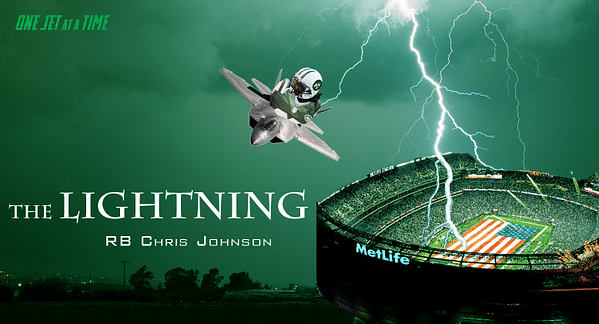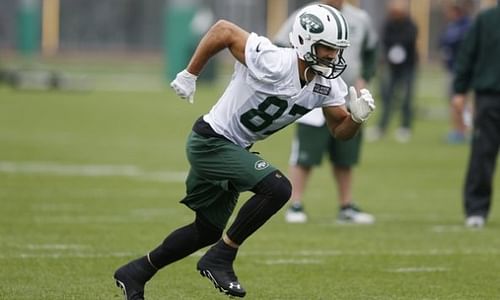
Offensive playmakers by way of free agency

This time last year, the New York Jets were among the bottom four or five teams in the league, according to most ESPN and NFL Network Power Rankings. The Jets’ 3-1 pre-season record did nothing to sway ESPN panel voters in the slightest; they ranked Gang Green dead last at 32, behind even the anemic Jacksonville Jaguars. Perhaps the Jets ranking was further deflated when Mark Sanchez injured his throwing shoulder in the ‘Snoopy Bowl’ – the Jets vs Giants pre-season matchup to claim MetLife Stadium – vacating the spot for the second round rookie Geno Smith. This and many other question marks encompassed the Jets offense.
A new coordinator in Marty Morningweg, an unproven but hopeful ‘workhorse’ RB in Chris Ivory, two tight ends both of whom have had their fair share of uncertainty, and a barren wide receiver group without a single proven playmaker – outside of maybe Jeremy Kerley – filled the roster.
It was a tall order for Marty and Rex, but they’d finish the 2013 season with an 8-8 record, finding success on the backs of the unsung heroes of the NFL.
Ryan knows, you win in the trenches.
The emergent D-line made opposing teams one-dimensional, consistently stuffing the run, while finishing the regular season ranked third in rushing yards allowed per game (88.2). On the other side of the ball, the turnover-prone rookie QB was protected by an offensive line unit that paved the way for the sixth-ranked rushing attack (134.9 yds/gm).
According to the most recent power rankings, the Jets aren’t soaring any higher than the middle of the pack. Can we expect the newly added free agents to help this Jets team ascend to higher altitude?
Believe it or not, the Jets dabbled quite a bit in free agency.
They opened slow and steady, but managed to acquire some top talent in WR Eric Decker and RB Chris Johnson. They also brought in Jacoby Ford to add some speed and depth on special teams and at WR.
In 2013, the Green and White ran a dual-back system, made up of the thrashing Chris Ivory and the versatile Bilal Powell. Ivory handled the power running, while Bilal pitched in from all angles, effectively rushing, receiving, and pass-blocking. Combined, the two amounted 1,530 total yards and four rushing touchdowns for an average of 4.3 yards per carry.
So what will the Jets look like when lightning strikes?

With Johnson presumably moving into the one spot at RB, the ‘dreaded storm’ (I love this but do not own the rights to it) of Chris ‘Thunder’ Ivory and Chris ‘Lightning’ Johnson will give the offense an added dynamic. The only downside, if any, of having Ivory on the field last season was that opposing defenses knew that he wasn’t catching out of the backfield. Over the entire season, Ivory caught the ball just twice, for a total of 10 yards. Ivory was still extremely effective in the ground game, but Johnson offers the art of surprise.
Adding CJ2K, who’s coming off his second best pass-catching season of his career – with 42 receptions for 345 yards and four TDs – will give opposing defenses all the more to think about. Not only did Johnson have a solid year receiving, he also rushed for 1,077 yards and six TDs. A total production of 10 TDs – one shy of the Jets’ running backs and wide receivers TD totals, combined, in 2013.
Johnson also gives the Jets a homerun threat. By now, most know that he holds the record 40-yard dash time, 4.24, at the combine, and although he’s probably not quite as fast as he once was, he can take it to the house if he finds a crease.
Was Peyton Manning Decker’s puppeteer, or is the fifth year WR that talented?
Eric Decker’s numbers with Peyton as the signal caller were impressive. To say his production wasn’t inflated, catching passes from one of the best QB’s of all time, on one of the most prolific offenses of all time, is fan talk. But the best assessment of what he brings to Gang Green probably lies between his 2011 and 2013 production.
In 2011, in his second year out of Minnesota, Decker was thrown to by the pedestrian Kyle Orton and an inaccurate winner in Tim Tebow. The inadequacies at QB were many, but Decker still found a way to be productive. Decker managed to rack up a team-leading 44 receptions for 612 yards and eight TDs. That season, Orton and Tebow combined for 217 completions on 426 attempts (50.9%).
By comparison, Peyton Manning averaged 425 completions on 621 attempts (68.4%) the seasons he played with Decker. Under Manning, the Broncos threw the ball 31% more than the Orton/Tebow duo of 2011, and were about 17% more accurate. Playing in a more pass happy offense may be indicative of why Decker had such production, but his development as a player must be a considered variable. Decker averaged 13.9 yards per reception in 2011 for eight TDs. In his two years with Manning, he averaged 13.7 yards per reception and 12 TDs.
Eric Decker is known for his big frame and strength, as well as his nose for the endzone. Is it just coincidence that he produced 33% more touchdowns in an offensive system that threw the ball 31% more often? Maybe. Is it coincidence that Eric Decker was producing the same yards per reception averages with Orton/Tebow at the helm? Maybe.
Perharps it’s not outlandish to put the spotlight on his development as a player, just as the proposed ‘Manning-inflation’ effect, to justify his increase in production. Just food for thought.
Was Jacoby Ford an insurance signing for the return game and at WR?

Jacoby Ford signed with the Jets on April 1st, one month before the draft. He spent four years with the Oakland Raiders, contributing as a return specialist and wide receiver. Ford was placed on IR for the 2012 season, after suffering a Lisfranc injury in the preseason, but rejoined the team in 2013.
Although Ford hasn’t offered a ton by way of the wide receiver position in his career, the acquisition is a good one for the Jets, if only to add speed to the return game, with the hope he’ll find his stride in the passing game.
During his 2010 campaign with Oakland, Jacoby broke the franchise record for most kickoffs returned for a TD, with three.
In 2013, the Jets failed to register a touchdown on kickoffs returns and punt returns. They had the 18th ranked kickoff return average with 22.7 and tied for 15th in the NFL with nine yards per punt return. The numbers were down in 2013 for a ST’s unit that had been in the top four-six for both categories, all four seasons prior.
Adding Jacoby gives the Jets a great speed option in the return game and gives Marty another unique peice to get creative on offense. He also provided flexibility, as Ford filled a ST’s need that the Jets wouldn’t be forced to address in the draft. With that being said, we should expect to see the fourth rounder, Jalen Saunders, in the return game. It’s just nice to reassurance.
We are three months away from playing games that matter. Much of this time will be spent assessing players and ranking teams, in anticipation of the 2014 season. Time will tell where the Jets land according to the analysts’ rankings, but don’t be suprised when they out perform expectations. Rex always seems to get more out of less, and this year he has more.